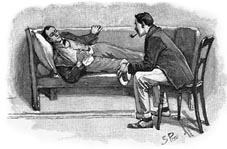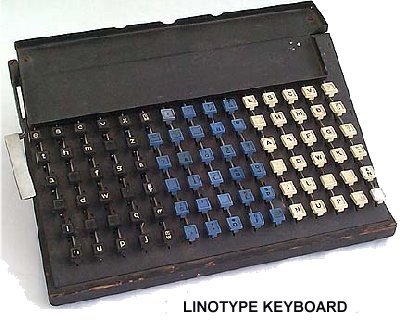
Lo, here lie calves! --- the first "dancing men" message
Shigeru Sugiyama
Sherlock Holmes was annoyed for two weeks with a message Hilton Cubitt sent to Baker Street in July 1898. The message was not ordinary one. It was written in hieroglyphics. It consisted of fifteen dancing men.
When Holmes received the message, he immediately recognised that the dancing men stood for letters. He then surmised that the message made up of fifteen symbols, or fifteen letters, was broken into four words. Words were indicated by the flags some of the dancing men held. Next, he observed that some of the dancing men appeared more than once. For reproduction in this paper, each dancing man has been replaced with a letter of the alphabet, resulting this:
ab cded afd ghaidj
Ten letters, different each other, are used in the four words. The first two-letter word shown as 'ab' may easily be regarded as AH, AM, AN, AS, AT, IF, IN, IS, IT and many others. The third word 'afd' may be AGE, AND, ARE, ASK, ATE, ICE, IMP, IVY and so on. It would be something like solving simultaneous equations in mathematics to solve the message and get a meaningful sentence or phrase given with the four words.
It would be observed that the dancing man represented above by 'a' appears three times, and 'd' four times, while each of other eight letters appears only once. Holmes said, "I am fairly familiar with all forms of secret writings, and am myself the author of a trifling monograph upon the subject, in which I analyse one hundred and sixty separate ciphers, but I confess that this is entirely new to me." He also said, "The first message submitted to me was so short that it was impossible for me to do more than to say with some confidence that the symbol 'd' stood for E." I wonder how he spent his two weeks trying to solve this short message. Did he try different combinations? How many? Obviously there are thousands. Holmes has covered sheet after sheet of paper with figures and letters, completely absorbed in his task, according to Watson's observation.
 He might have been a little bit presumptuous to state that 'd' stood for E, but one can with great probability say that 'a' and 'd' will be one of twelve letters of "ETAOIN SHRDLU." This queer and never-learnt-in-school phrase seems to be famous among specific circles. One example is found in old printing business. A linotype produces this slug by running fingers down the first two columns of the keyboard (see photo, by courtesy of http://typewriter.rydia.net ); ETAOIN from the top to the bottom of the very left column, and SHRDLU on the second left column. The other is more popular than above and is seemingly known well among enthusiastic word-gamers. This man-made phrase shows the order of appearance of letters in books and papers experimentally known for a long time, and so the letters of this phrase have been useful for playing word games such as Anagram and Scrabble.
He might have been a little bit presumptuous to state that 'd' stood for E, but one can with great probability say that 'a' and 'd' will be one of twelve letters of "ETAOIN SHRDLU." This queer and never-learnt-in-school phrase seems to be famous among specific circles. One example is found in old printing business. A linotype produces this slug by running fingers down the first two columns of the keyboard (see photo, by courtesy of http://typewriter.rydia.net ); ETAOIN from the top to the bottom of the very left column, and SHRDLU on the second left column. The other is more popular than above and is seemingly known well among enthusiastic word-gamers. This man-made phrase shows the order of appearance of letters in books and papers experimentally known for a long time, and so the letters of this phrase have been useful for playing word games such as Anagram and Scrabble.
Holmes said to Watson, "Speaking roughly, (E),T,A,O,I,N,S,H,R,D and L are the numerical order in which letters occur; but T,A,O and I are very nearly abreast of each other, and it would be an endless task to try each combination until a meaning was arrived at." If Holmes had been able to try every combination with a computer, he could have ended that "endless task" to solve the first message successfully, instead he had to wait for "fresh materials" that came in a fortnight or later. He certainly would have gotten a laugh out of some of the phrases his computer produced.
Shown below are the results of replacing the dancing men with the letters in the first "dancing men" message. The left hand columns indicate which letter is being substituted for dancing men 'a' and 'd.' Then meaningful sentences and phrases are shown in the central column.
| a |
d |
ab cded afd ghaidj |
Notes |
| A |
E |
Am here, Abe Slaney. |
or "Ace", "Ape" |
| Am Pete. Aye scared. |
or "soaked" |
| Ah, Pete! Ave, Isabel! |
ave = welcome, farewell |
| E |
A |
Ed Sara Eva Whelan |
|
| L |
E |
Lo, here lie calves! |
or "values"
lo = look, see |
| N |
S |
NY asks NBS honest. |
|
| O |
E |
OK. Mete one closer. |
mete = measure |
| OK. Mete one. Proved. |
or "Scored" |
| T |
A |
To Java TWA extras |
'extras' would mean extra flights. |
| U |
A |
UK Java USA Bhutan |
|
| U |
E |
Up here, use acumen. |
or "amulet", "faucet" |
With this list of computer generated phrases, Holmes would certainly have been able to solve the crime more quickly. Possibly he could have prevented his client's death, though it was probable, I fear, that he might have been misguided to wrong conclusions: He wanted to find Whelan family, or he looked for Pete and Isabel but not Abe Slaney. He might have been interested in seeing pastured calves, while it would be unimaginable that he might have set out on a trip to Java or Bhutan. I believe that Holmes would have found great uses for computers in his work. Who knows, maybe if Holmes had lived in the 1990's instead of the 1890's he would have relied upon his "good old computer" but not upon his "good old index"?
- Additional note -
My computer has successfully counted alphabetical letters in the sixty stories of Sherlock Holmes. The results of 'the numerical order in which letters occur' are ETAOIH-NSRDLU, where 'H' comes up in higher position. I surmise the reason why 'H' appears many times is that the letter is certainly included in 'Sherlock' and 'Holmes'. In the Canon 'Holmes' appears more than 3,000 times. The details of the results are:
E (338,000 12.3%) T (248,000 9.0%) A (224,000 8.2%) O (214,000 7.8%) I (189,000 6.9%) H (183,000 6.7%) N (182,000 6.6%) S (172,000 6.3%) R (157,000 5.7%) D (118,000 4.3%) L (109,000 4.0%) U (83,000 3.0%)
Total number of the letters is 2,743,000


 He might have been a little bit presumptuous to state that 'd' stood for E, but one can with great probability say that 'a' and 'd' will be one of twelve letters of "ETAOIN SHRDLU." This queer and never-learnt-in-school phrase seems to be famous among specific circles. One example is found in old printing business. A linotype produces this slug by running fingers down the first two columns of the keyboard (see photo, by courtesy of http://typewriter.rydia.net ); ETAOIN from the top to the bottom of the very left column, and SHRDLU on the second left column. The other is more popular than above and is seemingly known well among enthusiastic word-gamers. This man-made phrase shows the order of appearance of letters in books and papers experimentally known for a long time, and so the letters of this phrase have been useful for playing word games such as Anagram and Scrabble.
He might have been a little bit presumptuous to state that 'd' stood for E, but one can with great probability say that 'a' and 'd' will be one of twelve letters of "ETAOIN SHRDLU." This queer and never-learnt-in-school phrase seems to be famous among specific circles. One example is found in old printing business. A linotype produces this slug by running fingers down the first two columns of the keyboard (see photo, by courtesy of http://typewriter.rydia.net ); ETAOIN from the top to the bottom of the very left column, and SHRDLU on the second left column. The other is more popular than above and is seemingly known well among enthusiastic word-gamers. This man-made phrase shows the order of appearance of letters in books and papers experimentally known for a long time, and so the letters of this phrase have been useful for playing word games such as Anagram and Scrabble.